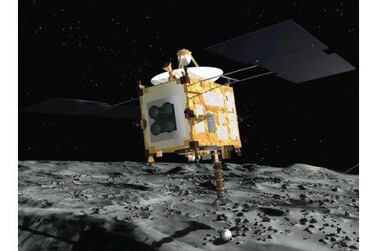A harpoon designed to capture floating space junk has been successfully fired for the first time 400 kilometres above the Earth as part of an international effort to tackle the growing danger from orbiting debris.
The harpoon pierced the centre of a tethered aluminium target in a test that researchers hope will clear the way for future industrial-scale operations to clear up space of tonnes of junk and decommissioned rockets.
Researchers working on the RemoveDebris satellite project hope that the successful harpoon test will result in specialist ‘space tugboats’ that can snag malfunctioning rockets and drag them towards Earth until they burn up on re-entry.
Our spacecraft operators here at SSTL had to do some very clever in-orbit analysis and spacecraft commanding to fire the @AirbusSpace harpoon on board the RemoveDEBRIS #smallsat - got it spot on! Watch the real-time & slo-mo video from the onboard cameras https://t.co/7gc7SvjXog
— Surrey Satellites (@SurreySat) February 15, 2019
They admit, however, that the prospect of such missions are years away as space continues to clog up with the debris of 60 years of space exploration. Scientists have tracked more than 21,000 pieces of man-made debris larger than 10 cm orbiting the Earth which pose a risk to future space exploration amid a boom in satellite launches.
Commercial launches under 500 kilograms are forecast to jump ten-fold to more than 5,600 in the 10 years to 2027, compared with the previous decade, according to consulting firm Euroconsult. A new generation of spacecraft can launch thousands of satellites in a single mission, said officials.
The dangers from astral debris were highlighted in 2009 when US and Russian satellites collided sending thousands of fragments into orbit, which remain a danger for modern craft.
British astronaut Tim Peake shared an image of a chipped window panel on board the International Space Station in 2016 which could have been caused by something as small as a chip of paint moving at thousands of kilometres-an-hour.
The harpoon project, developed by UK researchers, is ultimately aimed at catching some of the estimated 3,000 failed craft that pose the greatest dangers to orbiting satellites.
Modern guidelines state that modern satellites have to be pre-programmed for self-destruction within 25 years of the end of their missions. Some of the debris is a legacy of previous missions but malfunctioning rockets will increase the volume of junk.
“If we can remove a few of these fully intact space craft each year, it prevents them colliding and becoming huge numbers of smaller pieces of debris,” said Alastair Wayman, an advanced project engineer from Airbus, part of the consortium that developed the harpoon.
The harpoon test was carried out on a target just 1.5 metres from the satellite but officials believe the system could have an eventual range of around 30 metres. The £13 million mission last year trialled another potential system that used a net to slow and catch tumbling satellites.
The harpoon project is just one of a series of experimental projects being launched worldwide including one that uses chaser craft to capture satellites using magnets.
Japan’s government is also working with a century-old fishing net manufacturer to develop a wire mesh to fling debris out of harm’s way, Bloomberg reported.
The British experimental mission will end next month in a final test to reduce space waste when the 100-kilogram harpoon-launching satellite burns up on re-entry to the Earth’s atmosphere.







